Sri Lankan Lunu Miris
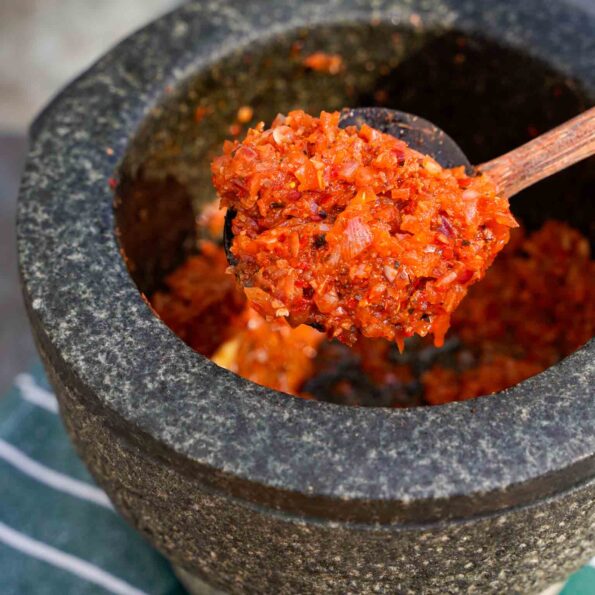
Sri Lankan Lunu Miris is a beloved traditional condiment that's super easy to make. Made from finely chopped onions, red chili flakes, salt, lime juice, and Maldive fish, it packs a punch with its bold, spicy, citrusy, salty, and umami flavors. It’s a must-have for some Sri Lankan dishes, including milk rice (Kiribati), coconut roti, and hoppers. Best of all, you can prepare it in under 10 minutes without any cooking!
** This post contains Amazon affiliate links for products.
Ingredients and Tools I use
Asian Shallots/ Red Onion: Traditionally, we use Asian shallots to make Lunu miris for their delicate flavor, adding a subtle yet essential base to the condiment. If you can't find Asian shallots, regular chopped red onions are a good substitute.
Red Chili Flakes: These bring the heat and color to Lunu Miris, giving it the signature spiciness that makes it so distinctive.
Chili powder: This is optional but it adds a vibrant red color to Lunu Miris. You can use a less spicy chili powder if you don't like heat.
Salt: A simple yet crucial ingredient, salt enhances all the other flavors, bringing balance to the condiment.
Lime Juice: Lime is a must! Freshly squeezed lime juice adds a zesty citrusy note, brightening up the overall taste and adding a refreshing tang. Lime is what we traditionally use but you can use lemon as well.
Maldive Fish Chips: These provide a unique umami depth to the Lunu Miris. They can be hard to find outside of Sri Lanka. If you can't get hold of them, feel free to skip this ingredient, the Lunu Miris will still be delicious without it! My dearest loku ammi (my mom's sister) is a vegetarian and her Lunu Miris is out of this world good, and she never uses Maldive fish.
Mortar and Pestle: I always use my 4-cup stone mortar and pestle to make Lunu Miris. I highly recommend it over a food processor since mortar and pestle help to bring out more flavor and you have more control over how much you want to blister your onions.
Food Chopper: When I'm too lazy to chop onions, I use this manual food chopper for that.
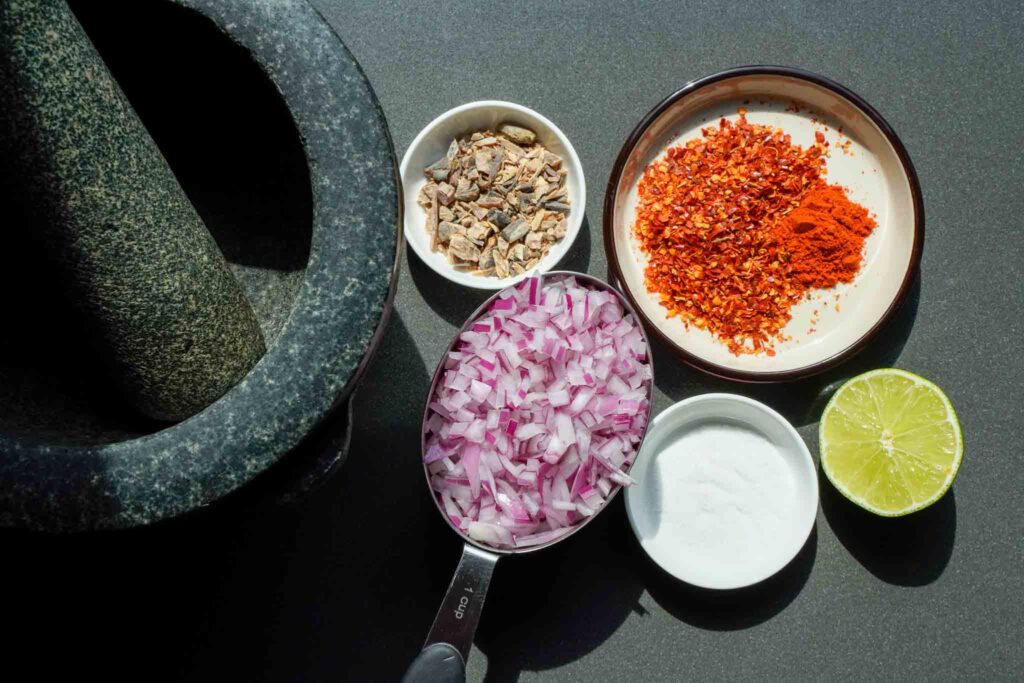
Additives to Make Lunu Miris Different Every Time
The recipe I’m giving you here is the simplest and basic recipe to make Lunu Miris. Do not get me wrong, the flavors are absolutely phenomenal. That being said, you can try adding the following ingredients to make it a little different, every time you make it.
Curry leaves: This adds both aroma and flavor to Lunu Miris. Add a small spring of curry leaves before you add onions and pound them until they break down very well.
Black Peppercorns: The Peppery flavor goes really well in Lunu Miris. Add about ½ tsp whole black peppercorns along with salt and pound them until they break down to a coarse powder.
Garlic: such a great addition for garlic lovers. Do not use too much though raw garlic can overpower the taste of everything. I usually add a small clove of garlic and that is more than enough to add a garlic flavor.
Tomato: I love adding chopped tomatoes, especially if I’m making a wet lunu miris for hoppers. I usually add about ½ of a tomato, finely chopped at the end of making Lunu Miris, and pound a few times to mix well. You may need to add a little bit more salt to round up the flavors.
Recipe Video
(The video might not appear if the ad blocker is on)
Sri Lankan Lunu Miris in a Food Processor
I often get questions about whether it's possible to make it in a food processor. Well the answer is yes BUT you need to be extra careful not to over-process it. The first time I made Lunu Miris in my food processor, it turned out so bitter and pungent that I had to throw away everything. The thing is when the onions are broken down too much it can taste extremely pungent. Keep on reading to find out the science behind it.
If you want to make it in the food processor, make sure to chop your onions finely before you adding it and pulse a few times just to mix everything through. Do not over-process it. Also, add a little bit of extra lime juice along with the onions. This helps to mask and counteract the pungent flavor. Another tip is to add a little bit of oil when you pulse onions. Oil can help reduce pungency by creating a barrier that limits the onions' contact with air. This can slow down the oxidation process that contributes to the strong, pungent flavors
Over-processing onions can make Lunu Miris Bitter
The bitterness that arises from over-processing red onions is due to the release of sulfur-containing compounds. When onions are cut, their cells rupture, releasing enzymes called alliinases. These enzymes react with sulfur compounds known as sulfoxides to produce various other sulfur compounds (ex thiosulfinates and thiosulfonates), which are responsible for the pungent taste and smell of onions.
Finely chopping or gently processing onions controls the release of these sulfur compounds, allowing their natural sweetness to balance the flavors. However, over-processing onions breaks down more cell walls, leading to a higher release of these sulfur compounds. This excess can overwhelm the palate, resulting in a pronounced bitterness and an unpleasant taste.
Additionally, over-processing can also release phenolic compounds and other bitter-tasting substances that contribute to the overall bitterness. To avoid this, it’s best to finely chop or gently pulse the onions in a food processor, stopping as soon as the desired texture is achieved. This method helps to preserve the balance of flavors and prevent the bitterness that comes from excessive processing.
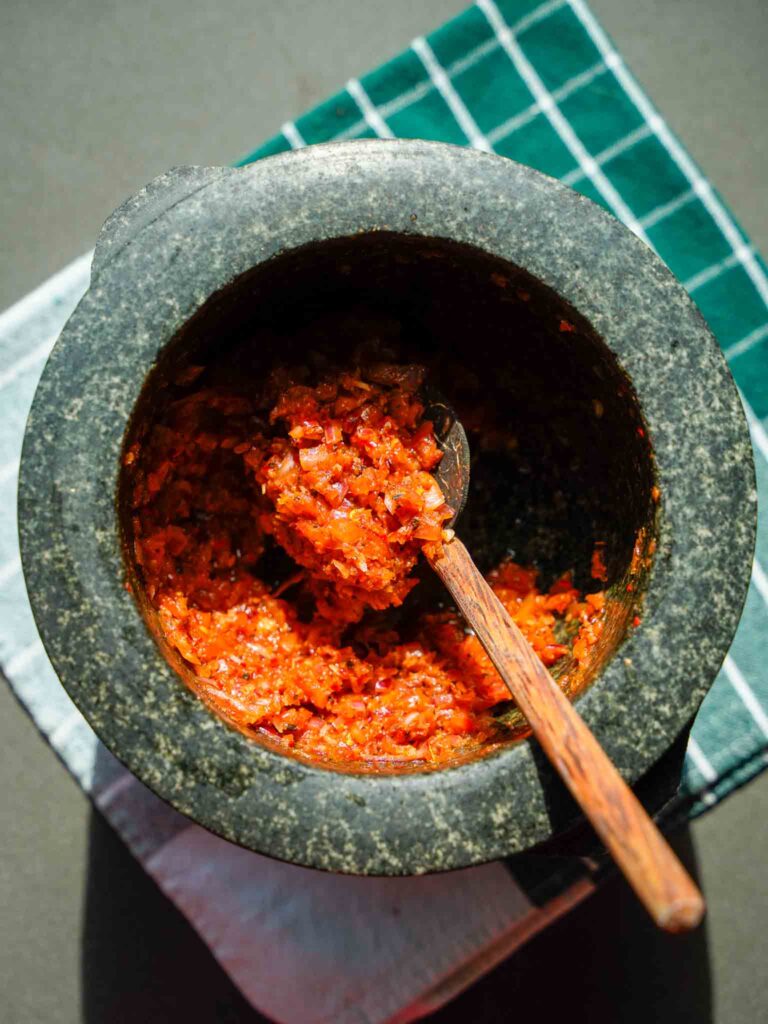
Serving Ideas for Sri Lankan Lunu Miris
Lunu Miris goes amazing with Sri Lankan Milk Rice, Coconut Roti, Hoppers, and Pittu. You can have it with rice as well. A few of my favorite menus that include Lunu Miris are:
- Sri Lankan Milk Rice (Kiribath) + Chicken Curry + Lunu Miris
- Coconut Roti + Red Pork Curry + Lunu Miris
- Sri Lankan Hoppers + Lunu Miris + Red Chicken Curry or Beef curry
- Rice + Potato coconut milk curry + Lunu Miris (this is the menu my mom makes when we recover from flu or don't have an appetite to eat anything)
I hope you give this wonderful spicy condiment a try. It's super easy to make an extremely forgiving. The key here is to get a good balance of salty citrusy and umami flavors. You can always taste it and adjust the seasoning to match your taste. If you try it, kindly add a star rating. It helps me immensely to run this blog and share more recipes with you. -- with love, Roshani
Sri Lankan Lunu Miris is a vibrant and bold condiment that packs a punch of flavors, combining spicy, citrusy, salty, and umami notes. It's incredibly easy to make in under 10 minutes with no cooking required.
- 2 tsp Chili flakes
- 1 tbsp Maldive Fish Chips
- 1/2 tsp Salt
- 1/2 tsp Chili powder (optional, make the lunu miris more red in color)
- 1 Cup Chopped red onion or Asian Shallots (1 cup is roughly about 120g)
- 2 tsp Lime Juice
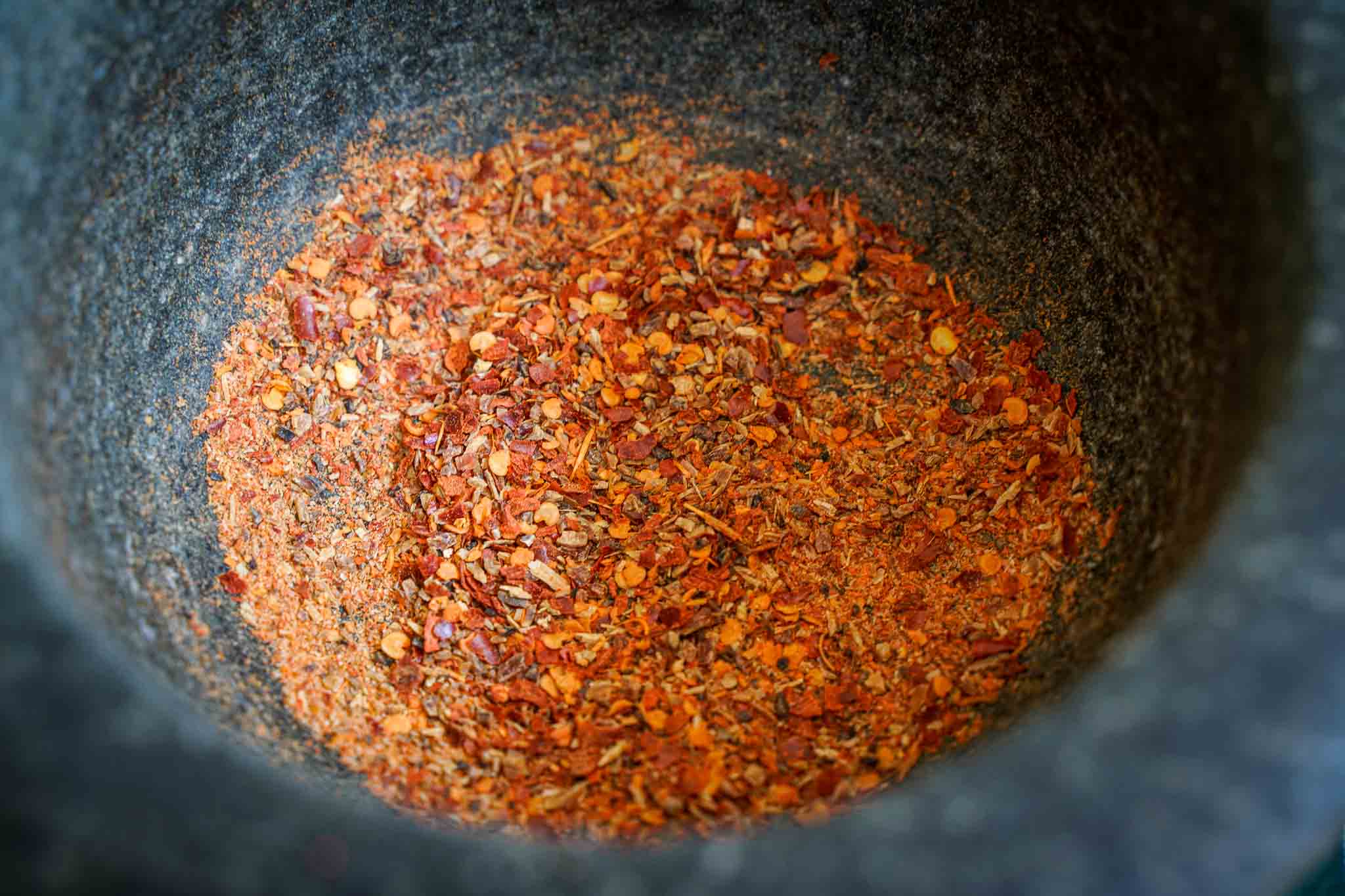
Add chili flakes, Maldive fish chips, salt, and Chili powder into the mortar and grind them until there aren't any big pieces of Maldive fish chips left. They could be hard to chew.
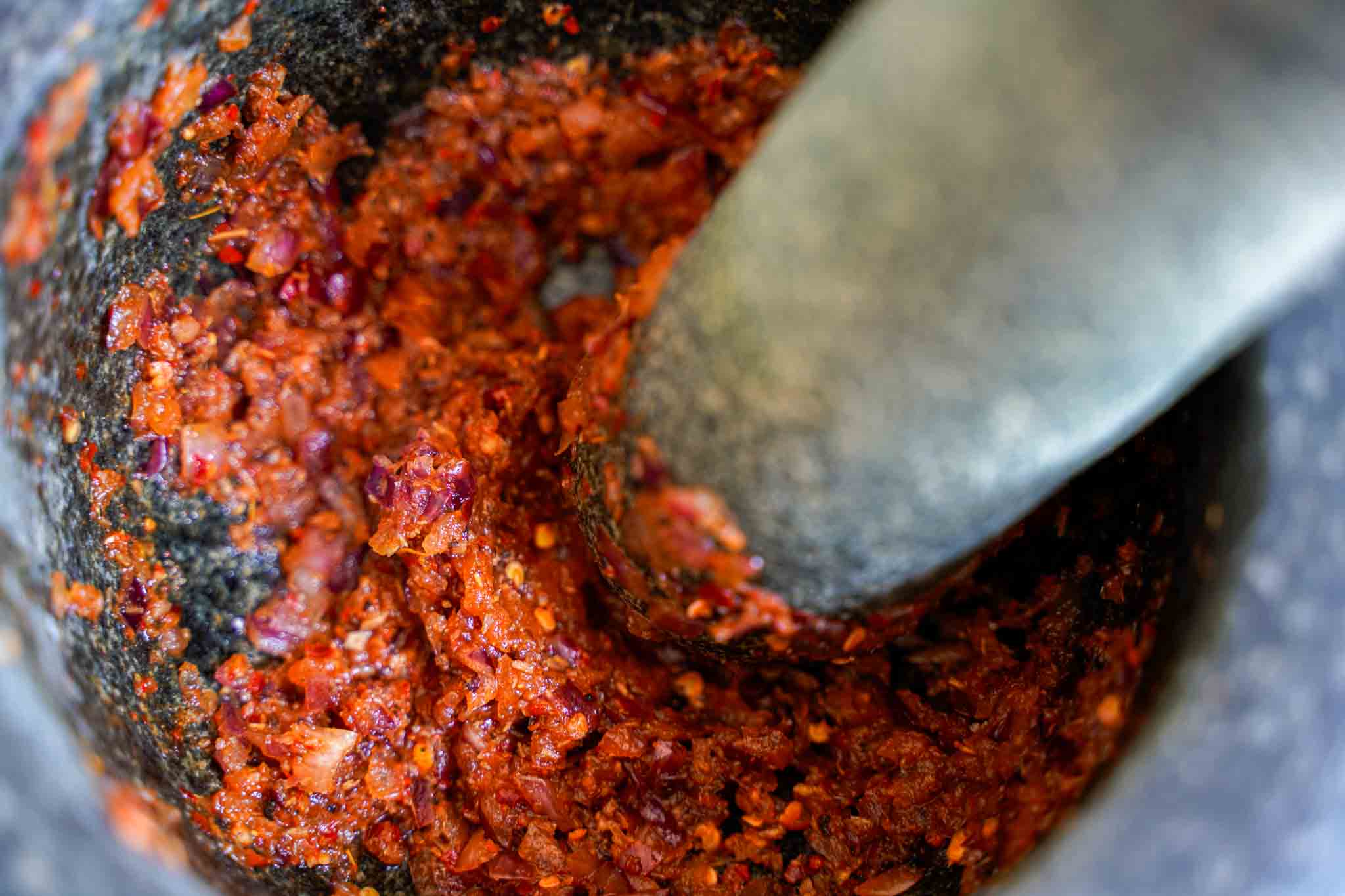
Add the onions. Pound with the pestle until onions and chilies are thoroughly mixed and turned into a rough paste.
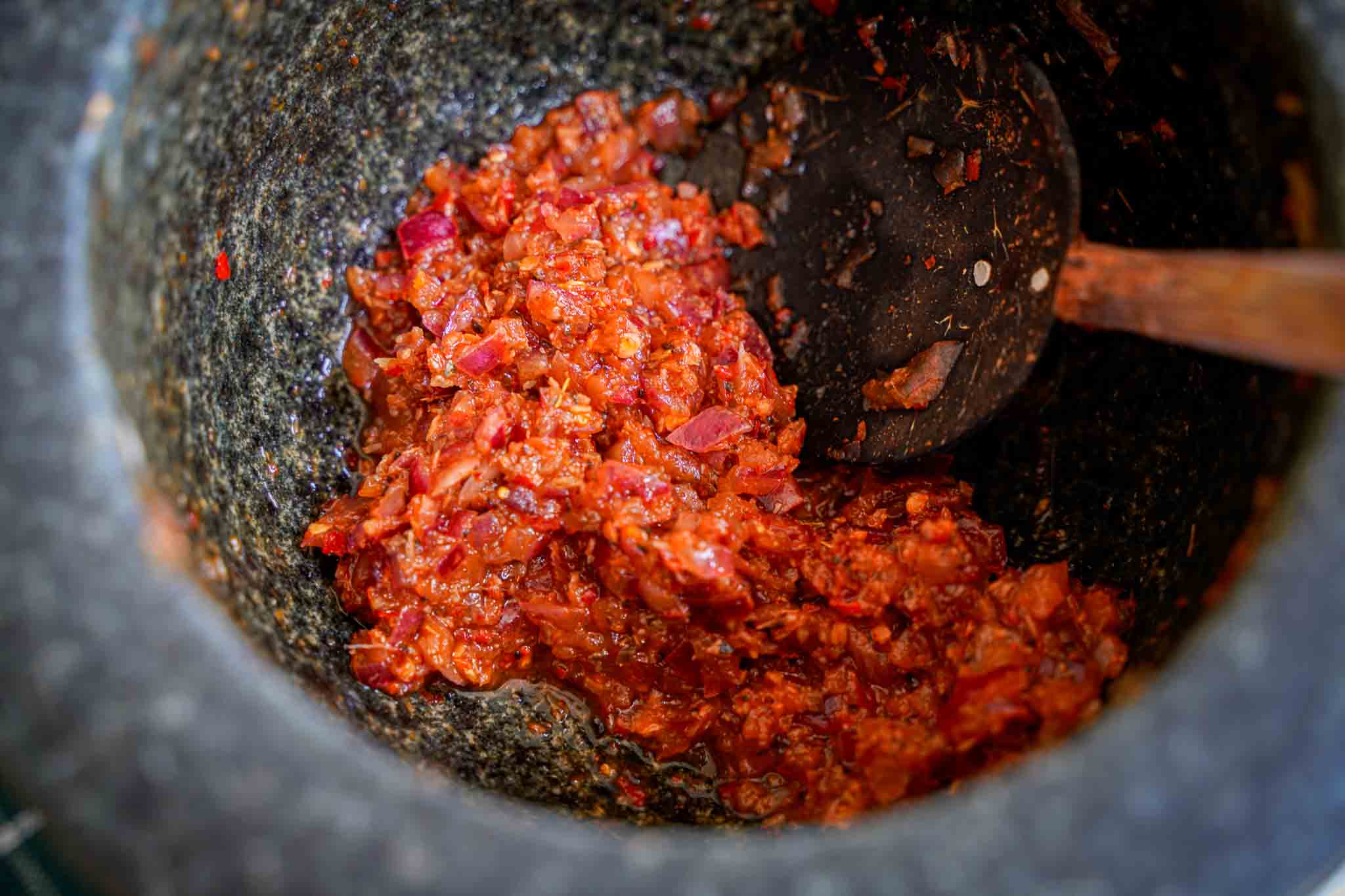
Add lime juice. Mix well with a spoon. Taste and adjust the salt and lime if needed. Lunu Miris should have a prominent citrus flavor. It's best to serve it freshly made.
